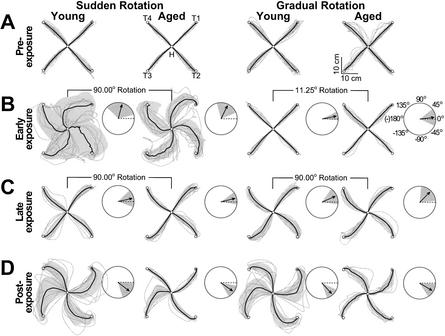Figure 2.
Screen cursor movement paths (mean ± SD) and normalized shifts of initial direction of movement (mean ± SD; insets) for the young and aged groups as a function of distortion type and stage of visuomotor adaptation. (A) Pre-exposure, (B) early-, and (C) late-exposure to a 90° CCW screen cursor rotation, and (D) post-exposure following removal of the screen cursor rotation. In these figures, the last two trials of pre- and late-exposure, and the first two trials of early and post-exposure for each subject per target direction (10 traces total per target direction for each condition) have been overlaid to show typical movement paths at different stages of learning (e.g., sharp reversals, spirals, loops, etc). (Insets) The dark vectors represent mean normalized shifts of the initial movement direction, collapsed across targets, from pre-exposure to early- (B), late- (C), and post-exposure trials (D), respectively. The mean initial direction of movement at pre-exposure (represented as a broken dark line) is set to 0°.

